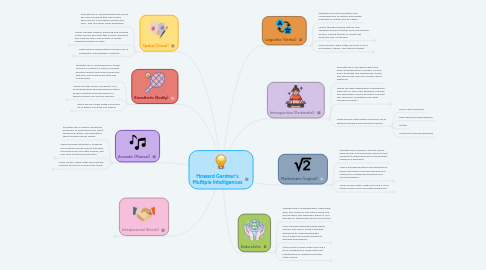
1. Spatial (Visual)
1.1. Strength lies in visualizing with the mind's eye and conveying that information externally by using shape, perspective, color, size, and other visual properties.
1.2. Learns through viewing, analyzing and creating visuals. Enjoys activities that involve looking at and creating one's own graphic or artistic depictions based on ideas.
1.2.1. Designing layouts and objects
1.2.2. Drawing/sketching pictures and ideas
1.2.3. Arranging elements based on color, patterns, and other visual aesthetics
1.2.4. Experimenting with lighting and color combinations through various tools
1.3. Often pursue career paths involving a lot of imagination and aesthetic creativity.
1.3.1. Architects
1.3.2. Illustrators and painters
1.3.3. Fashion designers and interior decorators
1.3.4. Photographers
2. Kinesthetic (Bodily)
2.1. Strength lies in controlling one's bodily motions in relation to a goal, including handling objects with one's hands and feet and controlling one's hand-eye coordination.
2.2. Learns through touch, movement, and processing ideas through physical action. Enjoys activities involving hands-on, physical stimuli and muscle memory.
2.2.1. Playing sports
2.2.2. Building and sculpting objects
2.2.3. Exercising and strengthening muscles
2.2.4. Dancing, touching, and gesturing
2.3. Often pursue career paths involving a lot of physical activity and motion.
2.3.1. Professional athletes
2.3.2. Construction workers and sculptors
2.3.3. Physical therapists and personal trainers
2.3.4. Dancers and actors
3. Acoustic (Musical)
3.1. Strength lies in auditory sensitivity, especially to analyzing sound, pitch, tempo and rhythm and replicating them through various means.
3.2. Learns through listening to, studying and creating sounds. Enjoys activities involving music and other sounds, and may even possess perfect pitch.
3.2.1. Creating and directing sound through instruments and sound-based technologies
3.2.2. Composing and combining patterns and rhythms so that others may replicate them
3.2.3. Studying the creation and reception of sound by organs, and the ways in which sound and music impact both the mind and body
3.2.4. Designing and arranging sounds and music to follow a logical pattern in media and entertainment
3.3. Often pursue career paths involving the creation and study of sound and music.
3.3.1. Conductors and musicians
3.3.2. Composers
3.3.3. Audiologists, music therapists and speech-language pathologists
3.3.4. Sound directors and designers
4. Interpersonal (Social)
4.1. Strength lies in socializing and collaborating with other people, as well as understanding their needs and feelings.
4.2. Learns through social interaction and teamwork. Enjoys activities involving group efforts and solving other's social and personal issues.
4.2.1. Investing interest in the problems of others and working to solve them through collaborative means
4.2.2. Discussing and reasoning through people's issues, and figuring out the best solutions based on the situational context and factors
4.2.3. Teaching and guiding groups of people through patience and understanding of their needs
4.2.4. Providing people with proper resources for the betterment of their situations
4.3. Often pursue careers involving a lot of social interaction and counseling.
4.3.1. Grassroots activists and politicians
4.3.2. Counselors, lawyers and psychologists
4.3.3. Teachers, motivational speakers, and consultants
4.3.4. Social workers
5. Linguistic (Verbal)
5.1. Strength lies in the facilitation and comprehension of written and spoken language by oneself and by others.
5.2. Learns through reading, writing, and speaking. Enjoys activities involving creative writing, reading (quietly or aloud) and acquiring new vocabulary.
5.2.1. Composing/reading stories, poetry, articles and essays
5.2.2. Studying the etymology and usage of words, pronunciations and speech patterns
5.2.3. Arranging sentences and words in ways that are meant to be appealing and comprehensible
5.2.4. Understanding different languages and carrying over information between them based on shared concepts and values
5.3. Often pursue career paths involving a lot of articulation, literacy, and textual analysis.
5.3.1. Writers and journalists
5.3.2. Linguists
5.3.3. Editors and speech writers
5.3.4. Translators and interpretors
6. Introspective (Existential)
6.1. Strength lies in self-examination and deep understanding of oneself, such as one's strengths and weaknesses; habits and personality; and one's beliefs about existence.
6.2. Learns through independent introspection, especially of one's own thoughts, feelings, and philosophy. Enjoys activities involving self-discovery, meditation and other individual pursuits.
6.2.1. Reflecting on and discovering one's place in the universe
6.2.2. Speculating about the nature of morality and existence, such as ethical conflicts, what exists beyond life, and how one can answer such questions for oneself
6.2.3. Pondering the reasons behind one's own actions and ideas
6.2.4. Figuring out ways to personally cope with problems and to better trust one's experiences and intuition
6.3. Often pursue career paths involving a lot of spiritual discipline and empirical pursuits.
6.3.1. Clerics and monastics
6.3.2. Theologians and philosophers
6.3.3. Writers
6.3.4. Counselors and psychologists
7. Naturalistic
7.1. Strength lies in understanding, interacting with, and caring for the natural world: the environment, the organisms within it, and the ways in which both affect one another.
7.2. Learn through interacting with plants, animals and nature. Enjoys activities pertaining to understanding the environment and factors behind its changes and behavior.
7.2.1. Caring for and observing the behaviors of animals and plants to better understand them
7.2.2. Working to preserve natural resources and analyzing changes in the earth and its ecosystems
7.2.3. Growing plants and raising livestock
7.2.4. Analyzing patterns in the weather and the potential ways the environment impacts it
7.3. Often pursue career paths involving a lot of engagement, observation and maintenance of organisms and the natural world.
7.3.1. Zoologists and botanists
7.3.2. Park rangers, conservationists and geologists
7.3.3. Farmers and gardeners
7.3.4. Meteorologists
8. Mathematic (Logical)
8.1. Strength lies in problem-solving, logical analysis and critical thinking, based on the capacity to understand and solve abstract systems of principles.
8.2. Learns through equations and deductions. Enjoys activities involving reasoning and methods for answering questions and solving problems.
8.2.1. Creating and solving questions and equations based on principles and methodologies
8.2.2. Making educated predictions based on logical observations
8.2.3. Drawing conclusions based on collected data and calculations
8.2.4. Collecting and calculating numeric information
8.3. Often pursue career paths involving a lot of logical analysis and calculated predictions
8.3.1. Mathematicians and scientists
8.3.2. Political analysts
8.3.3. Economists and statisticians
8.3.4. Accountants

